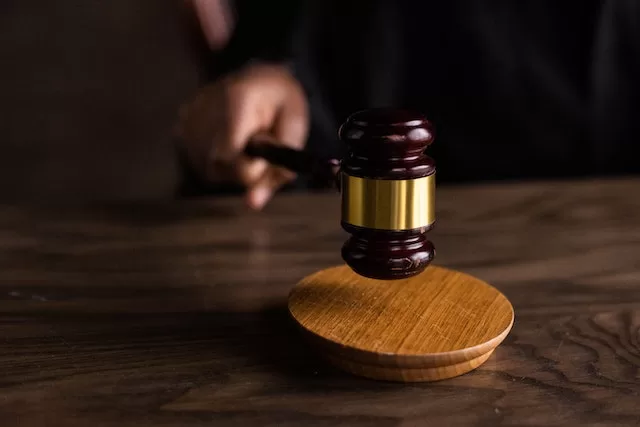A restraining order is typically issued by a court after a hearing where both parties have had an opportunity to present their case, while an injunction is usually issued without notice or a hearing.
What is a restraining order?
(Photo By Romain Dancre on Unsplash)

A restraining order is a court order that requires someone to stop doing something or to stay away from someone. The person who is ordered to stop doing something or stay away from someone is called the “respondent.”
What is an injunction?
An injunction is a court order that requires someone to do or refrain from doing a specific act. A party who violates an injunction faces criminal or civil penalties, including contempt of court.
Injunctions are issued in a variety of situations, including when two parties are involved in a lawsuit and one party wants to prevent the other from taking an action that would harm them. For example, if someone is suing another person for defamation, they may ask the court for an injunction prohibiting the other person from publishing any more defamatory statements about them.
Injunctions can also be used to protect public safety. For example, courts may issue injunctions prohibiting people from entering certain areas during a natural disaster.
There are different types of injunctions, including temporary restraining orders (TROs), preliminary injunctions, and permanent injunctions. TROs are typically issued without notice to the other party and only last for a short period, usually until a hearing can be held. Preliminary injunctions are issued after notice to the other party and often last until the case is decided by a judge or jury. Permanent injunctions are issued after a trial and last indefinitely.
When to get a restraining order or injunction?
If you are in immediate danger, call 911. If you are not in immediate danger but believe you are being harassed, threatened, or stalked, you may want to get a restraining order or injunction.
A restraining order is a court order that requires the person who is harassing, threatening, or stalking you to stop doing those things. A restraining order may also require the person to stay away from you and/or your family members, not contact you, and not go to your home or workplace.
An injunction is very similar to a restraining order; however, an injunction is filed with the clerk of court instead of going through a judge. An injunction may be appropriate if the person harassing you has done something that makes it likely they will continue to harass you even after being served with a restraining order.
The decision of whether to file for a restraining order or an injunction should be made after consulting with an attorney.
How to file for a restraining order or injunction?
(Photo By EKATERINA BOLOVTSOVA)

If you are a victim of domestic violence, you may be able to file for a restraining order or injunction against the abuser. Restraining orders and injunctions are legal orders issued by a court that prohibit the abuser from having any contact with the victim. They may also order the abuser to stay away from the victim’s home, work, or school.
To file for a restraining order or injunction, you will need to fill out a petition and submit it to the court. The court will then review the petition and decide whether or not to issue the order. If the order is granted, it will be served on the abuser and will be in effect for a certain period.
If you are in immediate danger, you can also call 911 to get help from law enforcement.
Can you be around someone with a restraining order?
If you have been served with a restraining order or injunction, you may be wondering if you can still be around the person who obtained the order against you. The answer to this question depends on the specific terms of the order.
Most restraining orders and injunctions will prohibit the person named in the order from having any contact with the person who obtained the order. This means that you would not be able to see or speak to the protected person, and would need to stay a certain distance away from them.
However, some orders may allow for limited contact between the parties. For example, an order may allow for communication only through a third party or may allow for supervised visits with children. If you are unsure about whether or not you are allowed to have any contact with the protected person, you should consult with an attorney.
What are the requirements for a restraining order or injunction?
A restraining order is a court order that requires an individual to refrain from certain activities. The requirements for a restraining order vary from state to state, but typically involve a showing of harm or the likelihood of harm if the restrained person engages in prohibited activities.
An injunction is a court order that requires an individual to take or refrain from taking a specified action. Injunctions are typically issued in civil matters, such as lawsuits involving contract disputes or allegations of harassment. Like restraining orders, the requirements for an injunction vary from state to state.
What happens if the defendant does not show up to a restraining order hearing?
If the defendant does not show up to a restraining order hearing, the judge may issue a warrant for the defendant’s arrest. If the defendant is arrested, he or she will be brought to court and may be required to post bail. The restraining order will remain in effect until the case is resolved.
What evidence do I need to get an injunction?
To get an injunction, you will need to go to your local courthouse and file a petition. You will also need to provide evidence of the abuse. This can include things like police reports, medical records, or witness statements.
A judge will then review your case and decide whether or not to grant an injunction. If they do grant an injunction, it will order the abuser to stay away from you and have no contact with you. They may also be ordered to surrender any weapons they have in their possession.
Violating an injunction is a serious offence that can result in jail time, so you must take measures to protect yourself if you have one in place.
What comes after an injunction?
After an injunction is filed, the court will set a hearing date. At the hearing, both sides will present their evidence and arguments. The judge will then decide whether to issue a restraining order or injunction.
What are the grounds for an injunction?
An injunction is a court order that requires someone to do or stop doing something. A restraining order is a type of injunction that specifically orders someone to stay away from another person or stay away from a certain location. There are several grounds on which an injunction may be issued, including:
1. To prevent being threatened with harm or actual harm to a person or their property;
2. To prevent interference with one’s constitutional rights;
3. To prevent nuisance or annoyance;
4. To prevent waste or dissipation of assets; and
5. To preserve the status quo (e.g., in family law cases involving child custody).
How long does an injunction last?
An injunction is a court order that requires someone to do something or refrain from doing something. Injunctions are often used to protect people from harassment, threats, or violence. An injunction can last indefinitely, but it is often only in effect for a set period.
What are the disadvantages of injunction?
1. It can be difficult to obtain an injunction.
2. Once an injunction is granted, it can be difficult to enforce.
3. Injunctions can be expensive to obtain and maintain.
4. They can also be disruptive to the lives of those involved, as they often involve restrictions on movement or contact.
What are the disadvantages of a restraining order?
1. They can be difficult to obtain, depending on the jurisdiction.
2. They may not be effective in stopping the behaviour they are meant to stop.
3. They can cost money to obtain and enforce.
4. They can take time to obtain, which may not be feasible in an emergency.
5. They can cause stress and anxiety for both the victim and the offender.
Photos by
Featured Image By – Towfiqu barbhuiya:








